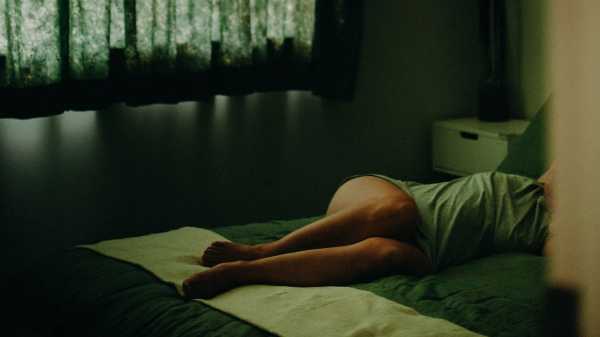
Save this storySave this storySave this storySave this story
Early in my first pregnancy, about three years ago, I did a thing that a lot of pregnant women do. I picked up my phone and scrolled through videos of pregnant women doing cool things. In one, a woman with a big belly—she must have been about seven months—was surfing. She wore a bikini, and her legs looked strong. Her hair blew behind her shoulders when she slid down a wave. When I watched the video, I thought, Wow, good for her! in a not-sarcastic way. Weeks later, on modified bed rest to protect my endangered pregnancy—marooned on my sofa, unable to confidently shower or walk upstairs for fear of triggering labor—I thought of the surfing woman again, this time huffily. “Good for her!” I said to myself, and returned to my book.
The book I was reading was Edith Wharton’s “The Custom of the Country,” from 1913. It’s the story of a beautiful social climber named Undine Spragg who attempts, through a series of opportunistic marriages, to infiltrate the highest ranks of New York society. I liked Undine because she existed in a time different from my own. Also, she did whatever she wanted. When Undine falls pregnant—a wrench in her plans—she throws a fit. Her husband tries to calm her down. “But, Undine—dearest—bye and bye you’ll feel differently—I know you will!” he says. “Differently? Differently?” she responds, in a rage. “When? In a year? It takes a year—a whole year out of life! What do I care how I shall feel in a year?”
Undine is selfish. She wants to look nice and go to parties. She’s not thinking of her husband or child or anyone besides herself. (Indeed, she turns out to be a pretty terrible mother.) Still, I admired her unself-conscious anger, her lack of shame. She’s mad, dammit! I texted a friend of mine, from the crumb-covered sofa where I was spending all my time, telling her that I’d tried to read “Wolf Hall”—a book about King Henry VIII trying to secure an heir—but that I’d had to stop because it’s all about wombs. “Oh god true,” she wrote back. “I suppose too now you see EVERYTHING is about wombs.”
Two weeks earlier, at the midpoint of my pregnancy, I had gone in for a routine scan. The National Health Service hospital in the part of North London where I live is one of those places—like a Roman ruin smashed between a barbershop and a Pret a Manger—where the city shocks me with its age. In the Northern California suburb where I grew up, where kids greeted the orthodontist like an old family friend, the medical facilities resembled office blocks or strip malls, and had gleaming interiors. In London, my hospital was housed inside a faded Victorian complex built during the smallpox epidemic. It sat on a site that opened in 1473 to treat lepers.
To get to my appointment, my husband and I passed a building with an enormous clock and a sign that read “Small Pox & Vaccination Hospital,” and entered into a separate building labelled “Female Receiving Ward.” A stained-glass window depicted the Madonna and child. I remember almost nothing from the scan except that the baby was fine. The technician moved the wand over my belly, making her checks. We saw the outline of his profile, his little nose.
Afterward, she printed a few photos for us to take home, and we examined them in a nearby café. This is going pretty well, I thought. My pregnancy thus far had been uneventful. Everything I had read about had happened on schedule. The powerful changes to my sense of smell and appetite. The swelling. The nausea. The nausea passing. The baby was a raspberry and then an avocado. He was growing ears and fingernails. I bought new clothes in an overpriced maternity shop. I continued writing stories. I went on vacation, and swam in the sea. My husband and I looked at each other. A baby!
An hour after our appointment, the technician called me. I was sitting at home trying to write. The baby was fine, but she had noticed a little funnelling around my cervix, she said. She hadn’t wanted to mention it at the time because she wasn’t sure exactly what she had seen. “O.K.,” I said. I tried to remember what the cervix did. The cervix should remain long and closed until the end of the pregnancy, she said. If it opens too early, you might have to get a stitch. “A stitch?” I said. It was probably nothing, she said. The doctor would call me if there was a problem. That was a Friday. The weekend passed. I Googled “cervix” and “funnelling” several times. “A marker of cervical insufficiency,” I read, “increased risk of spontaneous preterm delivery.” It seemed the cervix was really quite important. Funnelling can appear on a scan in the shape of a U, a V, or a Y. I tried to remember if I had seen a U, a V, or a Y during our scan. U, U, U, I thought. V, V, V.
On Monday, I was working at the British Library when the doctor called. I told him what the technician had said. He seemed annoyed. “She shouldn’t have told you that,” he said. The cervix is a dynamic organ, he explained. It can move and wave naturally throughout pregnancy without anything being wrong. I was youngish, and had no other red flags. Nothing in my family history. She shouldn’t have said anything at all, he went on, but since she had, and since I was now worried, he would book me in for a follow-up scan in a month’s time. He seemed busy.
I returned to my desk. I thought of my cervix waving and wiggling like action lines in a comic book. Zoing! Boing! Up until this point, I had felt proud of how I had been able to keep a lid on my anxiety during the pregnancy. I would breezily drink a coffee, and explain that Emily Oster had said in her book that it was absolutely fine to drink multiple cups a day. (And do you have a copy? I can lend you mine!) But here my covert Googling caught up with me. I booked a private scan for Wednesday. We had plans to travel to Sweden to visit my brother-in-law on Friday. “For peace of mind,” I kept saying, until the phrase lost its meaning.
On the way to the private scan, I ate a cold spinach-and-feta roll from a bakery in my neighborhood. One of the minor casualties of my pregnancy is that I can no longer eat one of these rolls without experiencing sickening pangs of adrenaline. (I still eat one occasionally, but I prepare myself ahead of time.) The doctor who examined my cervix was a soft-spoken Russian man who ran a small clinic in the financial district. Almost as soon as he inserted the probe, he fell quiet. He removed it carefully and asked me to get dressed. Very calmly—his voice was almost inaudible—he told me that my cervix was opening and I should go to the hospital. Immediately. We should hurry, he said. We might still have time. Perhaps we could take an Uber?
Time for what? I remember thinking. And then, Oh, no. We got in an Uber and crossed the city. “Good thing we ate beforehand,” I said, stupidly, as the car crept toward our ancient hospital. Once there, I was examined and my notes were reviewed. The soft-spoken Russian turned out to be a well-known expert, and his assessment was taken very seriously. I was told I would need an emergency surgery. By then, however, it was late in the evening and no consultants were available. I was placed in a room with curtains for walls to wait until morning.
I didn’t sleep well. All around me, women were in the last stages of their pregnancies, groaning, creakily uncomfortable, waiting for labor to start. I heard a woman to my left begging to be induced. I was only twenty weeks along and had hardly considered the mechanics of birth. My belly was still a small swell—a hill you might picnic on rather than a mountain to be scaled—and nowhere near an encumbrance. I didn’t feel qualified to be there.
In the morning, one doctor after another spoke with me. I seemed to have something called “incompetent cervix,” they explained. “Incompetent?” I said. I imagined my cervix as a well-meaning but chronically disorganized employee in the corporation of my body. “Whoops!” she’d say, cheerily, having mixed up the files again. The condition was also sometimes called short or insufficient cervix, one doctor said, apologetically. They would need to place a rescue cerclage around my short, incompetent, and insufficient cervix to prevent it from opening. I was presented with choices that didn’t feel like choices. The procedure carried a risk of miscarriage, they explained, but not doing it would almost certainly result in miscarriage. I signed the forms.
The surgery shares some similarities to a C-section. I received a spinal to numb my lower body and was awake while the doctors worked. My husband put AirPods in my ears to distract me. I tried not to think about my water breaking on the table. Afterward, everyone seemed relieved, and that was disconcerting. A midwife spoke with me in the recovery room. If my stitch held over the next twenty-four hours, that was a good sign, she explained. If it held during the following week, that was better. If I made it a month with the stitch intact, I would reach twenty-four weeks, or viability, when the baby has a better chance of survival. She suggested taking the next month off work. I should avoid stress, she said, and try not to exert myself. No lifting, no baths, no exercise, no sex. She offered to write me a note.
My first thought was, I can’t believe this lady thinks I can take a month off work. My second thought was, I can’t feel my legs. The situation seemed ludicrous. I had work to do. We were going to Sweden on Friday. I wasn’t even that pregnant. What was I supposed to do? Cross my legs and try not to go into labor for the next—I did a quick calculation in my head, one that I had avoided until that moment—five months? Yeah, right. Nice try, lady.
Pregnancy is forty weeks long, but it feels much longer on bed rest. When you’ve been asked not to move much in order to protect your unborn child’s life, time stretches out before you like a vast, inhospitable landscape. You must navigate this terrain, carefully, by the subtle markings left behind by previous travellers. In this strange land—a deserted space—time becomes a location, a place to get to. I will get to twenty-four weeks. I will get to twenty-eight weeks. If I can make it to thirty weeks. In the ten weeks I spent on modified bed rest, I sometimes imagined my body as a ship with holes in it travelling toward the safety of land.
In reality, I was not going much of anywhere. I shuffled between the bed, the bathroom, and the sofa in our living room. Our apartment, though charming, inconveniently occupied the top two and a half floors of a converted Victorian terrace house, and somehow contained four flights of stairs. Our bedroom was a cozy attic space that the previous tenants had probably used to store luggage. Lying on the sofa in the living room, I stared out the windows at the brick façades and clay chimneys of the houses opposite ours. Above them was a wide patch of sky, where I watched each afternoon fade into night.
At first, I felt nothing. And then I felt fear. I was afraid of the stairs. I was afraid to get dressed. I was afraid to bend down to tie my shoes. To roll out of bed incorrectly. In the days after returning from the hospital, I was afraid to shower, or make a sandwich, or open a window. Only lying again on the sofa could I imagine the pressure being taken off my cervix, the baby secure inside me.
What I knew about bed rest before my pregnancy came from literature. Victorian women fainting and being put to bed. Charlotte Perkins Gilman’s narrator in “The Yellow Wall-Paper” losing her mind while taking the rest cure. (I also knew about bed-rotting, from TikTok.) Rest as a treatment for illness became popular in the late eighteen-hundreds, after a physician named John Hilton published a collection of lectures on the subject, “Rest and Pain,” in 1863. Its use began to fall out of favor after the Second World War, when it became clear that injured soldiers recovered faster when they spent less time in bed. In pregnancy, however, despite evidence that it may cause harm, its use persists.
Virginia Woolf spent weeks of her life in bed, though not while pregnant. “I am in bed with influenza,” she wrote in her essay “On Being Ill.” “But what does that convey of the great experience; how the world has changed its shape; the tools of business grown remote; the sounds of festival become romantic like a merry-go-round heard across far fields.” In “Mrs. Dalloway,” she writes disdainfully of a doctor’s orders to “rest” in bed: “Rest in bed; rest in solitude; silence and rest; rest without friends, without books, without messages; six months’ rest; until a man who went in weighing seven stone six comes out weighing twelve.”
But in illness Woolf also found something mystical, a liminal space where “the whole landscape of life lies remote and fair, the shore seen from the ship far out at sea.” Those going to work were “soldiers in the army of the upright,” whereas the ill were “deserters,” and “outlaws.” “They march to battle,” she wrote, of the healthy. “We float with the sticks on the stream; helter skelter with the dead leaves on the lawn, irresponsible and disinterested and able, perhaps for the first time in years, to look round, to look up—to look, for example, at the sky.” Lying on her back, she notices that the clouds are magnificent. “Some one should write to The Times about it,” she joked. “One should not let this gigantic cinema play perpetually to an empty house.”
I had felt this heightened sense of dislocation once before, just before moving to London. The lease on my apartment in Brooklyn had ended, and, obliged to stay in the city for a few more weeks, I briefly rented the home of a cellist on the Upper West Side. I had never met the cellist—only spoken to her on the phone—but I knew from her apartment that she must be very tall. Her kitchen cabinets were built for someone a foot taller than me, and the gowns in her closet seemed suspended from a great height. I could not reach the pots and pans, and I never learned how to operate the stove. I felt then, as in the second half of my pregnancy, that I had stepped outside the confines of my ordinary life. Like Alice in Wonderland, I found that everything was suddenly too small or too large for my body. I had entered a temporary space, one in which I struggled to operate with the ease and efficiency to which I had grown accustomed.
At home, I took stock of my situation. I had been told by several doctors that the N.H.S. does not officially recommend strict bed rest during pregnancy. The research on the subject does not show that it prevents preterm labor, they explained, only that it can lead to blood clots and psychological distress for the mother. At the same time, I had been given a long list of restrictions to follow until the end of my pregnancy. Some were specific—no swimming, and no sex—but some were maddeningly vague. I was told not to lift anything heavy, but not what qualified as heavy. I was told not to walk too much, but not what distance counted as too much. I was told to avoid stress, as if stress were a Martini, or unpasteurized French cheese, and it would be selfish of me to indulge during pregnancy. Can’t you just wait?
One doctor told me to live a quiet life at home except for trips to the hospital. Another told me that women in Australia in my situation live their lives as normal. In London, one doctor suggested, hesitantly, that it was fine to meet a friend for a coffee down the street. Another said that I could make as many cups of tea as I liked. (Thank God!) I was told many times to use common sense and to listen to my body, even though my body had recently initiated preterm labor without so much as a warning cramp, like some deadly undercover operative. In what sense was my body trustworthy? The midwives were more conservative than the doctors, advising rest and more rest. “You’d never forgive yourself if something happened,” one said.
Before I became pregnant, I believed that most health queries could be answered by speaking to a doctor or examining the research. But bed rest is one of those gray areas at the far edge of women’s health where different doctors will tell you different things. Nathan Fox, a specialist in maternal-fetal medicine in New York, and a co-author, with Oster, of the book “The Unexpected: Navigating Pregnancy During and After Complications,” told me recently that, twenty years ago, during his training, people knew there was limited evidence that bed rest works. Still, doctors would prescribe it in pregnancies like mine. That hasn’t changed much, he said. “We’re in a situation where no one’s ever been able to show that it helps, but it’s hard to prove, like prove, that it doesn’t help.” The thinking behind bed rest—taking stress off the body, and pressure off the cervix—can make a kind of sense, he said. “So sometimes doctors, and sometimes patients, feel like, well, what’s the harm? Like, why not? Let’s do everything we can.”
A cervical stitch like the one that I received lasts, on average, six to nine weeks, but for many women it holds longer, often all the way to full term. I wanted desperately to make it to full term. Every book I had read about pregnancy told me that babies make valuable gains in the third trimester. The lungs and kidneys mature. The brain continues to develop. I did not want to lose any of that time. I would research the rules obsessively and then follow them perfectly. (I call this the Girl Scout method.) But what were the rules? Everyone had a different answer. Increasingly, it seemed like a choose-your-own-adventure scenario, one with the highest stakes possible.
Online, I discovered a community of anxious women who, like me, were desperate to understand what they could do to stay pregnant. Although cervical insufficiency—to use the slightly kinder term—is rare, it is not unheard of, affecting about one in a hundred pregnancies. And yet everyone with the condition seemed to have received different guidance. On a forum devoted to the subject, there were posts titled “What does bedrest look like for you?” and “Meaning of bedrest?” I learned that there were tiers of bed rest: from modified (light movement) to strict bed rest (very little movement) to full-on, bedpan-at-the-ready hospital bed rest. Like me, many posters were grasping for specifics. “When in bed, did you try to stay horizontal as much as you could?” one asked. “How much support did you use i.e. pillows and things like that? How many minutes/hours of the day did you allow yourself to be on your feet?” Another noted that although her specialist had said that she would be fine “walking around and doing normal things,” the nurses had said “not to go anywhere without a wheelchair.” “I’m a little confused,” she wrote.
Some women had lost multiple babies in the second trimester to cervical insufficiency. Others had given birth to a live baby at twenty-two weeks or twenty-four weeks, only to have them pass away in the neonatal intensive-care unit. Sometimes women had to fight with insurance companies for coverage of a cervical stitch, even when a doctor recommended one. Many women were told to simply try again, and remained undiagnosed until they had suffered several losses.
People wrote about the practicalities of bed rest. “How do you afford being put on bedrest?” one woman asked. The answers were about food stamps, unpaid leave, short-term disability, and shitty employers. Someone had heard of a family who moved into their garage and rented out their house. A teacher was working from a sitting position and asking her students to hand out papers. A nurse on modified bed rest was looking for “easy light weight pediatric” or “overnight school nurse” positions because her employer wouldn’t cover time off. Others wrote about marital disputes, weight gain, boredom, guilt, and sadness. “Just lying here 24/7,” one woman wrote. “Constantly worried and in that state of mental despair.”
I knew I was lucky. I was a writer who worked from home with an understanding employer. I had savings, a supportive spouse, and no other children to care for. I lived in a country where my medical needs were covered by the state. My husband started working at home to help me, and he placed the photo from our twenty-week scan next to his computer. We settled on a kind of modified bed rest. We would follow all the restrictions our doctors recommended. I would lie down often, but also sit, and stand, and walk a little each day. (I was paranoid about blood clots.) We were relentlessly positive, until one day, lying on the sofa, I started crying uncontrollably. I hadn’t yet felt the baby kick, but now I felt him straining against my stomach. He kicked and kicked, happily, experimentally, it seemed to me, not knowing he was now classified as “high-risk.” We were weeks away from viability. If he came now, he would not survive.
Never in my life had I been fearful to write. It had always come easily to me. But now I found, with hours of time to myself, that I could not write a single word. I could not finish the article I was writing for work. I could not keep a journal. Often, I couldn’t even text. I had taken to heart the doctor’s advice to stop working—Girl Scout—and my work was writing. At the same time, I felt a compulsion to make use of the empty weeks. If I was not working, what would I ideally do with five months at home? Learn Greek, or learn to knit, or read all of Proust. Outline a novel or write a screenplay. Host a salon. At the very least, write some thank-you notes.
In truth, I was too gripped by the drama of my pregnancy to focus on anything else. I was aware, at any given hour, of the developmental milestones being reached inside my belly. Of how many days remained before my next appointment. Of how many weeks remained before my due date. My body—calm, heavy, and growing heavier—was as still as I could make it, but my mind was spinning. I was both laser-focussed on the problem and helpless to do anything about it. I had always thought of my mind as separate from my body, and of my body as essentially less important than my mind. But now the roles were flipped. My body was doing the serious work of building and housing a baby, while my mind looked on like an anxious assistant. Anything I might produce with my mind during this time seemed woefully beside the point.
When I became pregnant, I imagined I would work right up to my due date. In my twenties, when I started working in a newsroom, the more senior women reporters who had children would swap stories about their water breaking in the office or finishing an article from their hospital bed. I received these anecdotes with admiration. They sounded badass, thrillingly adult, proof that having a baby wouldn’t hold you back as a writer. Plus, this was something our male colleagues could not do. Now I think more about the logistics. How quickly could you get to the hospital? And would you have to take the elevator down with Dan from payroll?
Weeks passed. I read the terrible news. I read the terrible forums. Every two weeks, I went to an appointment at the hospital to check the length of my cervix. Otherwise, I was often seated, or horizontal, or pacing around my apartment. Friends came over for dinner, and I spoke to them from the sofa. My husband cooked. My husband cleaned. I drank fake beers and fake gin-and-tonics, and was generally grouchy. I spoke to my parents on the phone. I saw a therapist on Zoom. I opened a Google doc and wrote the words “Lie down, sit down, lie down, sit down.”
One day, I decided to walk to the park on my own. I had been getting dressed from a supine position to avoid bending down, and I shimmied into a pair of pregnancy leggings. I walked slowly down the stairs in our apartment and out the front door. Before my pregnancy, I would run to the park several times a week. I would listen to thumping music and do knee-highs and butt-kicks to warm up. Now I walked excruciatingly slowly to the end of our block. It was cold, but I was sweating. I crossed a street, stopped, walked another block, stopped, and went into the park. Just inside the entrance, I sat on a bench. Sometimes, at a cervix scan, the doctor would ask me if I was feeling all right. “Your heart is beating like you’re running,” she said, once. I wished I were running. I was full of adrenaline and had nowhere to put it.
Twenty-four weeks arrived. Viability. I went to the grocery store but abandoned my basket when it became too heavy. A security guard just shrugged when I asked for help. Twenty-six weeks came. The baby books told me it was a good time for a babymoon. Twenty-seven weeks. Twenty-eight weeks. Our baby had all his major parts; now he just needed time to grow. I willed my stomach to balloon outward, even as my other muscles became weak. My legs had lost their tone, and I felt winded when I walked. Yet I wanted to be enormous, preposterously large. My pregnancy had taken over my life, and I wanted it to show.
One afternoon, I left the house for a celebratory drink with two friends. One of them had just finished a book, and the other had acquired an agent. I had almost nothing to say, but I desperately wanted to go. The plan was to have a drink and then take a cab to a theatre near King’s Cross station to see a movie. But traffic was heavy, and we decided to take the Tube instead. I had been to King’s Cross many times, but I had forgotten, or perhaps I had never noticed, that the tunnels in the station are exceptionally long. As we walked toward the exit, I began to feel nauseated, and then panicky. I thought of the stitch loosening with every step. Of my water breaking far belowground. Of running to escape the tunnels. It was selfish to see my friends, I thought. Selfish to leave the house. Selfish to see a movie. I thought of the midwife who told me I’d never forgive myself if something happened. The tunnels seemed never-ending. At last, we exited. I sat through the movie and took a cab home, relieved to lie down again.
When thirty weeks arrived, we started to think about the possibility that we would go all the way. The thought of a planned Cesarean at thirty-seven weeks—a little early, to allow the doctors to remove the stitch—made me giddy. Or maybe I would be one of those women who remained pregnant weeks after their due date, bouncing on an exercise ball and eating dates to encourage labor. (This sounded romantic to me at the time.) The overpriced maternity clothes I’d bought in early summer finally fit me. I texted a friend that I was thinking about writing again.
By then, it was mid-December and the sun was setting every day by 4 P.M. That week, there was a snowstorm, and the roads were icy. I had a cold and had been sneezing all day. On Friday night, we decided to cross the city in an Uber to celebrate my brother-in-law’s birthday. I climbed into the car carefully, and winced at every bump in the road. I would just sit, I thought. I would just sit down and talk to people. When we arrived, the party was warm, with booze on the table and a Christmas tree in the corner. I felt joyful, simply sitting there on someone else’s couch, surrounded by friends.
Mid-conversation, I felt something between my legs. Was it wet? I kept talking. But it was still there. I excused myself and walked carefully to the bathroom, where a huge gush of water fell out of me. My leggings were wet. My shoes were wet. It would not stop coming. I returned to the party to find my husband. He was smiling and chatting, looking relaxed as he hadn’t in a long time. In the second he turned to look at me, I could see that he knew what had happened.
Because of the weather, we had trouble finding an Uber. Someone at the party—she had been a famously volatile movie star’s assistant and was utterly composed—volunteered to drive us to the hospital. She drove carefully, silently, along the icy roads, while water continued to spill out of me. I was thirty weeks and five days along. Almost ten weeks away from my due date. The stitch had held for close to the average amount of time a rescue cerclage tends to last.
I’ve thought about that day many times. If I had been stricter with myself—if I had, for instance, stayed in bed except to use the bathroom—would I have made it any further? (Actually, I did at one point briefly try to get myself admitted to the hospital, but was kindly turned away.) Alternatively, what if I had been more relaxed? What if I had gone out more? Walked around more? Been less of a control freak? Would I have saved myself a lot of trouble for the same outcome? I’m not sure. I hope that we did the best we could with the information we had. There are some things we’ll probably never know.
At the hospital, everything happened very quickly. At first, they hoped I might stay on hospital bed rest for a few more days. Then contractions arrived and grew stronger and stronger. The baby was in distress. The baby’s heartbeat could not be found. I remember a young doctor trying to locate it, a look of intense concentration on his face. The edges of my vision blurred. I squeezed my eyes shut. I felt like I was dying. We were dying. Suddenly, the heartbeat was there, and I was rushed into surgery. Our baby came out screaming, raw and red and angry, but indisputably alive. A midwife took a photo that I have never been able to look at.
Our son was whisked away. I didn’t get to hold him, or even see him, until hours later, when I was taken to the NICU in a wheelchair. He was a good weight for his gestation, almost four pounds, his minute features exquisitely formed. He stayed in the NICU for six and a half weeks, where doctors monitored his oxygen levels and lung development, his heart rate and weight gain. At first, he slept nearly all the time, a tiny, perfect baby in an incubator that looked like a spaceship. Every morning, I arrived with a cooler of pumped breast milk and sat beside him until the evening. I talked to him, and held him against my chest. As he neared his due date, he began to wake up. He wanted milk. He wanted cuddles. He was growing into himself. We had a long road ahead of us, but when we finally left the hospital I felt a relief so intense that it seemed as though my body would dissolve. Our son was safe. He was healthy. He had survived a treacherous crossing.
Recently, I found myself in the tunnels beneath King’s Cross station again. Our son is two and a half now, and we were returning from a vacation. Our son loves trains, and he spent the journey walking the aisle, excitedly opening and closing the doors between the cars. I know all parents think their children are beautiful, but in my case this is surely more fact than opinion. Our son has long eyelashes and big brown eyes and sandy blond hair. He thanks bus drivers when we exit buses and points out the swans in the park. He calls squirrels “quiz-rolls” and loves blueberries. He will throw his arms around me and say, “Thank you for my hug!”
During those weeks of rest, I thought of each day as a blank stretch. An in-between space, like a particularly uncomfortable waiting room. I do my best thinking while walking outside or staring out the window of a train. I love eating on the run, the sense of being on the way to something. Now my life is full of movement again. I’m often chasing after our son or rushing to get him somewhere. My arms are strong from carrying him. Lately, I have come to think of that period of relative stillness as a creative time. In a literal sense, it was more productive than any other ten-week span of my life. But those weeks have also come to encapsulate, for me, many aspects of parenting. Sitting with fear and uncertainty. Making peace with your decisions. Hoping for the best.
In the tunnels, we walked, and walked, and the memory of walking them during my pregnancy came back to me. I was walking slowly again, but this time it was because I was wearing a backpack and pushing a stroller crammed with supplies: sticker books and water bottles, and tiny containers of apple slices. Our son leaned forward, captivated by the flow of people around us and the curved ceilings of the tunnel. “We’re going on the train!” he said. ♦
Sourse: newyorker.com







